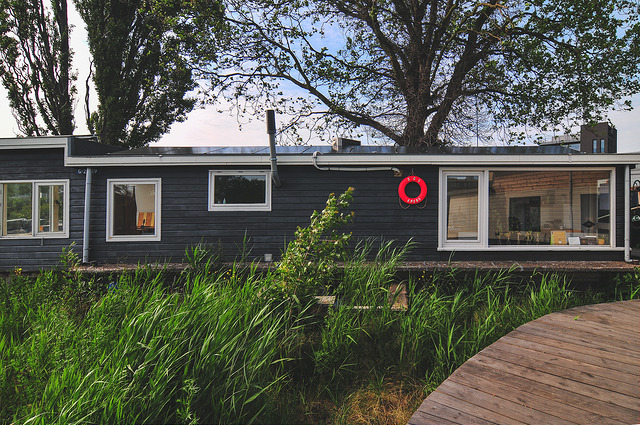During my 6 month foray into blogging, Jeremy Williams has become my hero. I love the way he writes, the frequency of his high quality blogging, but most of all the amazing stories he tells. Today I’m sharing the story he published on February 1st. The story itself is jaw-dropping. Also, it illustrates the myriad ways divestment can be alot more than a financial tactic. It’s something I’ve been thinking a lot about. The sustainable Dutch city he describes divests its bad habits and hazardous baggage and re-invests in sustainable lifestyles, pristine ethics, and inclusivity; it envisions economies that are holistic, circular, without silos. May there be many more of these exciting ventures, and may they inspire a kinder, gentler, more level playground for us all.
De Ceuvel’s playground for sustainable cities is like a fairly tale. First the Dutch port is unraveling, heading towards the uninhabitable. An upscale development could be on the horizon, as has happened in other waterfront locales. But the financial recession buys DeCeuvel some time. Then the wood nymphs and tree-huggers joined forces with the alchemists to design a transitional space, a new kind of Middle Earth. Parts of it will survive for generations – accessible, green, innovative, fair. A magical garden that can detoxify poisons is created. Then, if patience prevails, a vibrant affordable green community will emerge.

Here’s the blueprint…compliments of Jeremy Williams.
It began with a vision: co-working space for artists, entrepreneurs and sustainability researchers. Basically, a series of radically renovated houseboats were joined together along a winding boardwalk within a former shipyard. A garden between these boats was constructed so phytoremedical plants will draw toxins out of its polluted soil. In ten years the site will have cleaned itself and be ready to host something else. What an amazing example of restorative development.

How does circularity figure into this 10 year experiment?

1.Food waste generated by the cafe or the businesses goes into a wormery. Also waste is separated, with urine going through a struvite reactor to extract the minerals and produce an odourless white fertilizer. Solid waste is composted through the toilets and then a tumbler. The wormery and waste system create byproducts that are reused in the gardens, a greenhouse and aquaponics system. That, in turn, produces food for the cafe.
2.Each houseboat/office has solar panels and the boats are insulated and have heat exchangers, which provide for heat as well as power. Each boat has a smart meter that records output from the solar panels and the occupants’ usage. When an office generates a surplus, it earns points in a local cryptocurrency called ‘Jouliettes’. These points can be exchanged with other boats when they need to draw more power. As the area around De Ceuvel regenerates, there are plans for Jouliette to become a functioning local currency based on solar power.
How will this create an affordable community?
Waterfront land makes a wonderful location for apartments and local amenities, but post-industrial land is polluted. To make it safe, historically polluted soil has been mechanically removed, which is time consuming and costly. In Buiksloterham, where De Ceuvel is, the local people had time to figure out what they could do differently. For one, they will encourage self-building of eco-homes. They aspire to create the most sustainable neighborhood in Europe.
So, rather than move to Vermont, if Bernie Sanders came upon a time machine, I bet he and Jane would high tail it to De Ceuvel. It has it all, Amsterdam close by, Brooklynesque eco-business incubators, a cool community of progressives….and most likely a non-existent population of methane-spewing cows.
Check out the De Ceuval website – it’s awesome and explains things like struvite reactors and other esoteric (hopefully not for long) sustainability apparatus. It also offers tourism opportunities!

